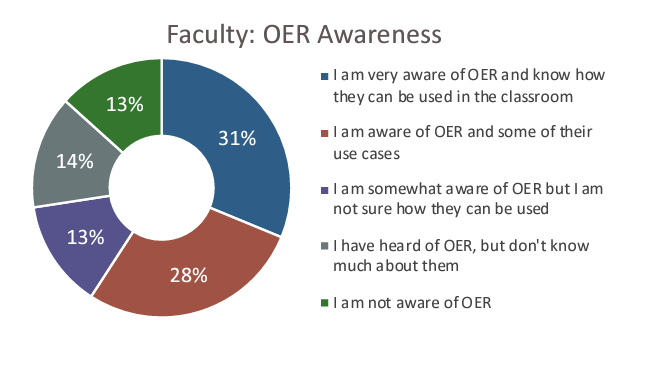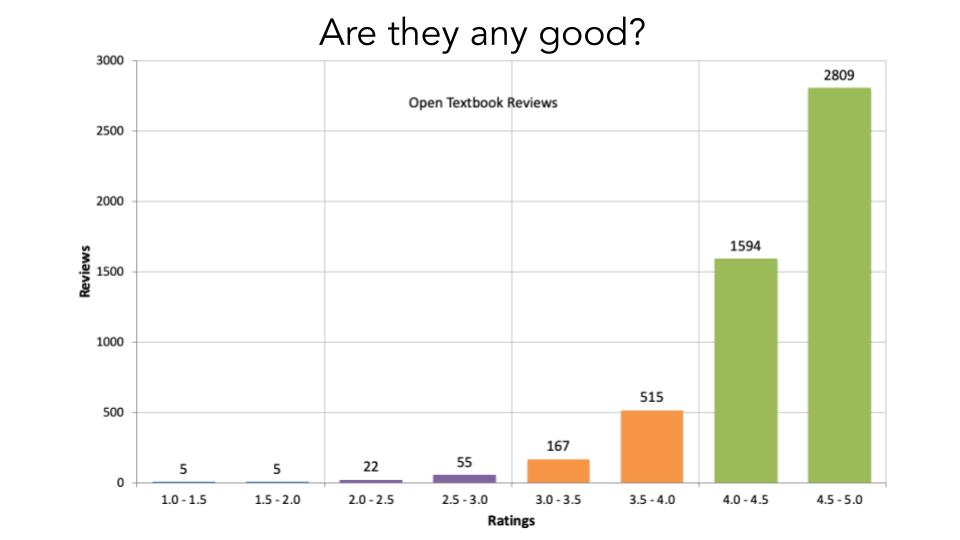7 Researching Open Educational Resources
What does the research say about OER?
By: The Council of Chief State School Officers. Video: CC BY 4.0. Music: Lahaina by Blue Dot Sessions: CC BY NC 4.0. Transcript
By the end of this chapter, one will be able to :
-
- Understand areas of research in Open Educational Resources
- Identify ways to research Open Educational Resources adoption
Introduction
An important part of learning about open educational resources (OER) is understanding the research being done is this arena of open content. Baseline research has shown that OER “do no harm,” meaning they are of good quality and serve students as well as or better than traditionally published materials (Jhangiani et al., 2018). Further studies have shown that instructors knowledge about and use of OER is increasing; students benefit from courses using OER, and the quality of this material is considered to be good. The Cost/Outcomes/Use/Perceptions (COUP) framework is a useful model to follow for those wanting to do their own research into the effectiveness of OER.
Learning Objective Check-in
Awareness and Perception
Research shows that instructors’ knowledge about and use of OER is increasing. According to a 2023 study by Bay View Analytics, 85% of instructors had some type of awareness of OER. Beyond awareness, “1 in 2 instructors used OER materials, and about 1 in 3 instructors required an OER material in at least one course.” Survey leads did not identify a singular factor in the rising levels of awareness or usage, but a mix of factors. This mix includes OER offering more affordable course materials and professors becoming more familiar and comfortable with searching for and using online resources (Coffey, 2023). An additional study of over 450 instructors “found that autonomous motivation (engagement with OER textbooks based on enjoyment, value) was the strongest positive predictor of current and future OER textbook use” (Herbert et al., 2023).

Faculty: OER Awareness by Julia E. Seaman, PhD, and Jeff Seaman, PhD (Bay View Analytics) under CC BY 4.0
How to Raise Awareness
- Share knowledge with department colleagues
- Write about personal experience
- Present to discipline at conferences or events
- Provide a review for an OER
Student Impact
Research on OER shows its beneficial impact on students. A large-scale study showed that OER adoption helped student success metrics: grades improved and drop/fail/withdrawal rates decreased, with heightened results in these areas for Pell grant recipients (Colvard et al, 2018). Textbook affordability efforts encourage students to sell textbooks back at the end of each term, but this strategy can lead to students selling books early in finals week, losing study access in order to meet bookstore quotas (Butcher 2012). With zero-cost OER, we eliminate textbook cost coping measures, and potential risks.
The FLVC Textbook Survey consistently reports how textbook costs hamper students’ academic gains. It makes sense that eliminating or reducing this cost burden should positively increase their academic progress.

Zero Textbook Cost Data
Statewide Florida Shines ZTC Data Dashboard:
Use and Quality
How to Research Implementation
Many questions about the impacts of OER adoption can be addressed through the COUP Framework. This framework focuses on the issues of:
- Cost
- Research Question: How much money was saved by this OER adoption?
- The amount saved is the difference between the cost of the previous textbook and the cost of the OER.
- Research Question: How much money was saved by this OER adoption?
- Outcomes
- Research Question: How do students’ final grades differ when instructors assign OER instead of commercial textbooks?
- Research Question: How do Course Throughput Rates change when instructors assign OER instead of commercial textbooks or digital content as the required materials for a course?
(The Course Throughput Rate or CTR, combines the effect of drop rates, withdraw rates, and final grades to show the percentage of students present on the first day of class who complete the course with a final grade of C or better.) - Research Question: How do students’ enrollment intensity (number of credits taken) and semester-to-semester persistence change when instructors assign OER instead of commercial textbooks or digital content as the required materials for a course?
- Use
- Research Question: How does student use of resources differ between traditional learning resources and OER?
- Research Question: To what extent (if any) are instructors and students utilizing the legal permissions facilitated by OER?
- Perceptions
- Research Question: How do students perceive the quality of the OER?
- Research Question: How do instructors perceive the quality of the OER?
There are many additional resources for learning more about OER research. Please visit the Guidebook to Research on Open Educational Resources Adoption for information regarding OER research tools such as:
- Data collection templates
- Data definitions
- Sample student surveys
- Sample instructor surveys
- Links to completed sample studies
- Resources for completing Institutional Review Board protocols
Research on Quality
The Open Education Network (OEN) reports that instructor reviews of OER collected in their Open Textbook Library are consistently high. Eighty-two percent of the reviews rated the textbooks in the top two quality categories (4 to 4.5 and 5 to 5.5).

Intro to OER Adoption Workshop Are they any Good Slide (2024) by Open Education Network (OEN) under CC BY 4.0
Leader Voice
“OER degree pathway implementation can contribute to transformational institutional change…At many of colleges, adoption of OER is spreading beyond clear issues of student affordability to the less obvious issues of access, completion, reducing time to degree, decreasing debt, advancing equity, and rethinking pedagogy, setting into motion policy, funding and systems change at the institutional, state and federal level.“
Dr. Karen A. Stout, President & CEO
Achieving the Dream
Conclusion
This chapter introduced areas of OER research. Using the COUP framework instructors can research their OER implementation. Sharing the results of OER implementation can continue to raise awareness and provide great research to include in tenure and promotion portfolios.
Assessment
Learner Survey

